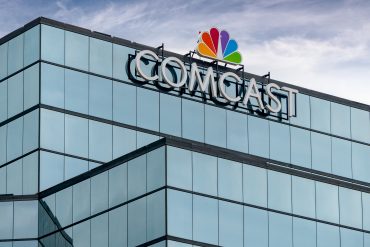
- Earnings Season
- Stock Market
- Streaming
- Telecom
Comcast Posts $30.3B Revenue as Streaming and Mobile Grow
6 minute read

Comcast’s broadband pricing overhaul and wireless growth boost quarterly profits despite losing 226,000 internet subscribers
Key Takeaways
- Comcast beats Q2 earnings expectations with EPS of $1.25 versus $1.16-$1.17 estimated and revenue of $30.31 billion surpassing $29.8 billion forecast, driving shares up 4% in premarket trading.
- Broadband subscriber losses total 226,000 in Q2 2025, though less severe than the 256,000 decline analysts projected, prompting strategic pricing overhaul with five-year price locks and transparent costs.
- Wireless growth adds 378,000 lines reaching 8.5 million total mobile subscribers, while Peacock revenue surges 18% to $1.2 billion as Comcast diversifies beyond traditional cable services.
Introduction
Comcast delivers a mixed but encouraging second quarter, beating Wall Street earnings forecasts while grappling with its largest broadband subscriber losses since 2021. The cable giant reports adjusted earnings per share of $1.25 and revenue of $30.31 billion, surpassing analyst expectations despite losing 226,000 domestic broadband customers.
The results underscore Comcast’s challenge in a saturated broadband market and highlight the company’s strategic pivot toward wireless services and content. Investors reward the performance with a 4% premarket stock gain, viewing the subscriber losses as less severe than feared while acknowledging progress in growth segments.
Key Developments
Comcast introduces a fundamental shift in broadband pricing strategy following customer feedback about lack of transparency and predictability. The new model features higher initial costs but slower price increases, five-year price locks, and free mobile lines for the first year. This approach abandons the industry’s traditional deep upfront discounts followed by sharp post-promotion price hikes.
The connectivity and platforms segment posts 0.7% revenue growth driven by a 5.4% increase in connectivity revenue. Meanwhile, pay TV subscribers decline by 325,000 during the quarter, reflecting ongoing cord-cutting trends across the industry.
Comcast’s content division demonstrates strong performance with NBCUniversal reporting 2% revenue growth to $6.44 billion. Universal theme parks surge 19% in revenue to $2.35 billion, bolstered by the successful opening of Epic Universe. The media segment achieves 9.3% EBITDA growth despite a 7% decline in domestic advertising.
Market Impact
Comcast shares rise approximately 4% in premarket trading as the earnings beat offsets concerns about broadband losses. The company’s adjusted EBITDA of $10.3 billion exceeds analyst projections, while net income reaches $11.12 billion including a $9.4 billion gain from selling its Hulu stake to Disney.
The wireless segment continues its expansion trajectory with record quarterly additions, bringing total mobile subscribers to 8.5 million. According to CNBC, this growth helps offset some concerns about the broadband segment’s performance, though not yet at sufficient scale.
Peacock maintains its 41 million subscriber base while significantly improving its financial performance with quarterly losses narrowing to $101 million from $348 million in the previous year. The streaming service’s revenue growth of 18% to $1.2 billion demonstrates progress toward profitability targets.
Strategic Insights
The results illuminate Comcast’s transition from a traditional cable company to a diversified media and telecommunications provider. Wireless services emerge as a key growth driver, though the company needs accelerated expansion to fully compensate for broadband declines. The strategic focus on customer experience and pricing transparency represents a significant departure from industry norms.
Comcast’s content and experiences division proves its value with consistent growth across theme parks and streaming services. The planned spinoff of cable networks including CNBC signals management’s commitment to focusing resources on higher-growth segments. This structural shift positions the company to compete more effectively in evolving media consumption patterns.
The broadband market’s saturation challenges extend beyond Comcast to the entire industry, with subscriber growth stalling even after government assistance programs expired. This environment favors companies with diversified revenue streams and strong wireless offerings, giving Comcast potential competitive advantages.
Expert Opinions and Data
“We delivered solid financial results in the second quarter, growing Adjusted EPS by 3% and generating $4.5 billion of free cash flow, while continuing to invest in our growth businesses,” states Brian L. Roberts, Chairman and CEO of Comcast Corporation. The company’s leadership emphasizes renewed focus on customer experience and acknowledges urgent needs to address customer pain points.
Analysts react positively to the results, noting that broadband losses, while significant, fell short of the most pessimistic projections. The market rewards Comcast for demonstrating early success with its pricing strategy overhaul and wireless momentum. Industry observers express cautious optimism about the company’s ability to stabilize broadband performance while scaling growth in adjacent markets.
Financial metrics support management’s strategic direction with net cash from operating activities increasing 65.4% to $7.8 billion. Capital expenditures decline 1.7% to $2.7 billion, reflecting disciplined allocation, while the company returns $2.9 billion to shareholders through dividends and share repurchases.
Conclusion
Comcast’s second quarter demonstrates the company’s ability to generate strong financial returns while navigating significant market transitions. The combination of better-than-expected earnings, strategic pricing reforms, and diversification progress positions the telecommunications giant to address broadband market saturation challenges.
The results validate management’s emphasis on transparency and customer experience while highlighting wireless services and content as viable growth engines. Comcast emerges from the quarter with renewed investor confidence and clear strategic direction for competing in an evolving telecommunications landscape.








